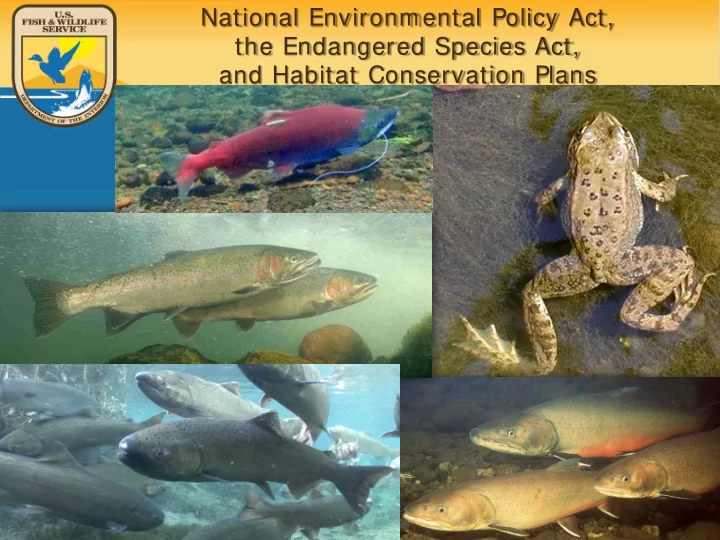

National Environmental Policy Act, the Endangered Species Act, and Habitat Conservation Plans
National Environmental Policy Act, the Endangered Species Act, and Habitat Conservation Plans Why are we here? • The DBBC and the City of Prineville are preparing a Habitat Conservation Plan (HCP) for several Deschutes River-dependent species. • In response, USFWS will prepare an Environmental Impact Statement (EIS) under the National Environmental Policy Act (NEPA) for the HCP. • Preparation of an EIS, triggers scoping.
ESA/ NEPA Processes
Scoping Why do Scoping? • Scoping engages the public and asks for input • The process identifies significant environmental issues for further analysis • Other, less significant environmental issues, are identified but further analysis may not be necessary.
Scoping • Get involved to help us identify important issues • Give us your comments the public comment period goes through September 22, 2017
NEPA Options
Scoping We want comments on: – Alternatives to the proposed action – Measures to avoid, mitigate, or minimize effects – Existing environmental conditions in the basin – Permit duration – Covered species and activities – Biological goals and objectives of the HCP – Any other significant issues
National Environmental Policy Act The NEPA process: • Is required for the Service to approve an Applicants’ HCP. • Helps the Service make decisions based on our understanding of the environmental consequences of approving the HCP. • Is used to identify and take actions that protect, restore, and enhance the environment. • Analyzes the effects of all the alternatives considered.
National Environmental Policy Act NEPA considers the impacts of a federal action on elements of the human environment such as: • water quality • wetlands • air quality • socio-economic and cultural resources • fish and wildlife species including ESA-listed
Environmental Impact Statement and Habitat Conservation Plans The Service will prepare an EIS because the HCP is likely to: – Cover a significant portion of the basin – Cover multiple species and multiple activities – Cover water management activities in the basin – Affect the human environment and listed species
Environmental Impact Statement What does an EIS include? Purpose and need for the action Alternatives (no action, proposed action, others) Affected environment Environmental effects of the alternatives Cumulative effects
Endangered Species Act
Endangered Species Act Purpose • To protect and recover imperiled species and the ecosystems upon which they depend.
Endangered Species Act Species listed as endangered or threatened: • ‘Threatened’ means a species is likely to become endangered within the foreseeable future throughout all or a significant portion of its range. • ‘Endangered’ means a species is in danger of extinction throughout all or a significant portion of its range.
Endangered Species Act (ESA) ESA protects endangered and threatened species and their habitats by prohibiting “take” • Take means “to harass, harm, pursue, hunt, shoot, wound, kill, trap, capture, or collect or to attempt to engage in any such conduct.”
Endangered Species Act (ESA) • Section 9 of the ESA states it is unlawful for anyone to take endangered or threatened species. However…. • Section 10 of the ESA allows incidental take of threatened and endangered species, if take occurs under an approved habitat conservation plan.
Habitat Conservation Plans • Incidental Take refers to take that results from carrying out an otherwise lawful activity (for example, residential and commercial development, or road construction) • A Habitat Conservation Plan is a voluntary plan developed by a non-Federal applicant in order to receive an incidental take permit.
Habitat Conservation Plans The Applicant’s HCP must describe and include: • Impacts likely to result from the taking of the species • Measures the applicants will take to minimize and mitigate impacts • Adequate funding to perform those measures • Alternative actions that would not result in take and reasons those alternatives are not being used • Additional measures as required by the Service
Habitat Conservation Plans To approve the Applicant’s HCP and issue an incidental take permit, the Service must determine: • Taking is incidental • The Applicants will, to the maximum extent practicable, minimize and mitigate the impacts of the taking • The Applicants ensure adequate funding for the plan • The taking will not appreciably reduce the likelihood of the survival and recovery of the species in the wild • Any measures required by the Service will be met
Next Steps/ Timeline • NEPA Scoping -Public comment period ends 9/22/2017 • Draft EIS and draft HCP – Public comment period (2018) • Final EIS and final HCP – Public comment period (2019) • HCP Implementation
Contact Us Send comments to: Peter Lickwar peter_lickwar@fws.gov More information: http://bit.ly/DeschutesHCP August 14-15, 2017
Recommend
More recommend